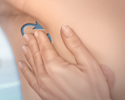Breast cancer screening
Mammogram - breast cancer screening; Breast exam - breast cancer screening; MRI - breast cancer screeningBreast cancer screenings can help find breast cancer early, before you notice any symptoms. In many cases, finding breast cancer early makes it easier to treat or cure. But screenings also have risks, such as missing signs of cancer. When to start screenings may depend on your age and risk factors.
Breast cancer
Breast cancer is cancer that starts in the tissues of the breast. There are two main types of breast cancer:Ductal carcinoma starts in the tubes (du...
Read Article Now Book Mark ArticleMammograms
A mammogram is the most common type of screening. It is an x-ray of the breasts using a special machine. This test is done in a hospital or clinic and only takes a few minutes. Mammograms can find tumors that are too small to feel.
Mammograms
A mammogram is an x-ray picture of the breasts. It is used to evaluate some breast symptoms and to find breast cancer in women with no symptoms....
Read Article Now Book Mark ArticleMammography is performed to screen women to detect early breast cancer when it is more likely to be cured. The recommendations of different expert organizations can differ.
- Mammography is generally recommended for all women starting at age 40, repeated every 1 to 2 years.
- Women with a family history of breast cancer should work with their health care provider to assess their risk of breast cancer. In some situations, additional testing may be considered.
Mammograms work best at finding breast cancer in women ages 40 to 74. It is not clear how well mammograms work at finding cancer in women age 75 and older.
Breast Exams
This is an exam to feel the breasts and underarms for lumps or unusual changes. Your health care provider may perform a clinical breast exam (CBE). You can also check your breasts on your own. This is called a breast self-exam (BSE). Doing self-exams may help you become more familiar with your breasts. This may make it easier to notice unusual breast changes.
Breast self-exam (BSE)
A breast self-exam is something a woman does at home to look for changes or problems in her breast tissue. Many women feel that doing this is import...
Read Article Now Book Mark ArticleKeep in mind that breast exams do not reduce the risk of dying from breast cancer. They also do not work as well as mammograms to find cancer. For this reason, you should not rely only on breast exams to screen for cancer.
Not all experts agree about when to have or start having breast exams. In fact, some groups do not recommend them at all. However, this does not mean you should not do or have breast exams. Some women prefer to have exams.
Talk with your provider about the benefits and risks for breast exams and if they are right for you.
MRI (Magnetic Resonance Imaging)
An MRI uses powerful magnets and radio waves to find signs of cancer. This screening is done only for women who have a high risk for breast cancer.
MRI
A breast MRI (magnetic resonance imaging) scan is an imaging test that uses powerful magnets and radio waves to create pictures of the breast and sur...
Read Article Now Book Mark ArticleWomen at high risk for breast cancer (greater than 20% to 25% lifetime risk) should have an MRI along with a mammogram every year. You may have a high risk if you have:
- A family history of breast cancer, most often when your mother or sister had breast cancer at an early age
- Lifetime risk for breast cancer is 20% to 25% or higher
- Certain BRCA mutations, whether you carry this marker or a first degree relative does and you have not been tested
- First degree relatives with certain genetic syndromes (Li-Fraumeni syndrome, Cowden and Bannayan-Riley-Ruvalcaba syndromes)
It is not clear how well MRIs work to find breast cancer. Although MRIs find more breast cancers than mammograms, they are also more likely to show signs of cancer when there is no cancer. This is called a false-positive result. For women who have had cancer in one breast, MRIs can be very helpful for finding hidden tumors in the other breast. You should do a MRI screening if you:
- Are at very high risk for breast cancer (those with a strong family history or genetic markers for breast cancer)
- Have very dense breast tissue
Benefits and Risks of Screenings
When and how often to have a breast cancer screening test is a choice you must make. Different expert groups do not fully agree on the best timing for screening.
Before having a mammogram, talk to your provider about the pros and cons. Ask about:
- Your risk for breast cancer.
- Whether screening decreases your chance of dying from breast cancer.
- Whether there is any harm from breast cancer screening, such as side effects from testing or overtreatment of cancer when it's discovered.
Risks of screenings can include:
- False-positive results. This occurs when a test shows cancer when there is none. This can lead to having more tests that also have risks. It can also cause anxiety. You may be more likely to have a false-positive result if you are younger, have a family history of breast cancer, have had breast biopsies in the past, or take hormones.
- False-negative results. These are tests that come back normal even though there is cancer. Women who have false-negative results do not know they have breast cancer and delay treatment.
- Exposure to radiation is a risk factor for breast cancer. Mammograms expose your breasts to radiation.
- Overtreatment. Mammograms and MRIs may find slow-growing cancers. These are cancers that may not shorten your life. At this time, it is not possible to know which cancers will grow and spread, so when cancer is found it is usually treated. Treatment can cause serious side effects.
References
Henry NL, Shah PD, Haider I, Freer PE, Jagsi R, Sabel MS. Cancer of the breast. In: Niederhuber JE, Armitage JO, Kastan MB, Doroshow JH, Tepper JE, eds. Abeloff's Clinical Oncology. 6th ed. Philadelphia, PA: Elsevier; 2020:chap 88.
National Cancer Institute website. Breast cancer screening (PDQ) - health professional version. www.cancer.gov/types/breast/hp/breast-screening-pdq. Updated March 28, 2024. Accessed May 20, 2024.
US Preventive Services Task Force; Nicholson WK, Silverstein M, Wong JB, Barry MJ, Chelmow D, Coker TR, Davis EM, Jaén CR, Krousel-Wood M, Lee S, Li L, Mangione CM, Rao G, Ruiz JM, Stevermer JJ, Tsevat J, Underwood SM, Wiehe S. Screening for Breast Cancer: US Preventive Services Task Force Recommendation Statement. JAMA. 2024 Apr 30. Epub ahead of print. PMID: 38687503 pubmed.ncbi.nlm.nih.gov/38687503/.
- Breast cancer(Alt. Medicine)
- Colorectal cancer(Alt. Medicine)
- Prostate cancer - InDepth(In-Depth)
- Prostate cancer(Alt. Medicine)
Review Date: 8/15/2022
Reviewed By: Todd Gersten, MD, Hematology/Oncology, Florida Cancer Specialists & Research Institute, Wellington, FL. Review provided by VeriMed Healthcare Network. Also reviewed by David C. Dugdale, MD, Medical Director, Brenda Conaway, Editorial Director, and the A.D.A.M. Editorial team. Editorial update 05/22/2024.



